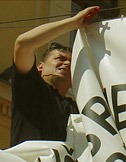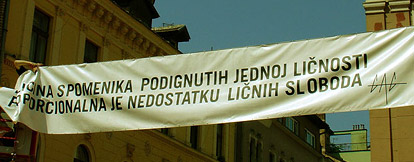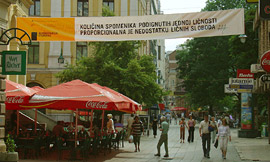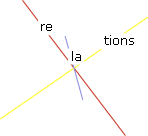|
|



FormatsArtist presentations, discussion forums, exhibitions, artistic interventions in public space, art and media productions, publications, political platform, new monumentsProject leadershipDunja Blažević, Sarajevo Center for Contemporary ArtTeamAmra Bakšić Čamo, Larisa Hasanbegović, Sanela Bojadžić, Enes HuseincehajićAdvisory boardMarina Gržinić (artist, curator and art critic, Ljubljana); Jakob Finci (president of the Interrelations Council in Bosnia and Herzegovina, Sarajevo); Želimir Košcević (director of the Museum of Contemporary Art, Zagreb); Shkëlzen Maliqi, (philosopher, director of the Center for Humanistic Studies Gani Bobi, Prishtina); Borka Pavičević (director of the Center for Cultural Decontamination, Belgrade)PartnersUrban Movement, Mostar> Center for Informative Decontamination, Banja Luka > The Children's Movement for Creative Education, New York Other supporters> Open Society Fund Bosnia and Herzegovina
|
What is the common denominator for the successor states of the Federal Republic of Yugoslavia? The creation of nation-states (the process is still in progress) based on national or nationalistic ideologies and policies continues to dominate the Balkan political space. The result of such policies is not (only) liberation from the domination of the bigger and stronger, or the struggle against the aggressor in order to safeguard one's "own territory" and national integrity, but also the ethnic division and homogenization of a people, accomplished through the perpetuation of a feeling of endangerment and fear of the other. Thus the raison d'être of these new states is ethnic homogeneity - unity. One collective ideology - "the rule of the working class" - was exchanged for another - "the rule of the (ethnic) nation." The reigning national policies have their equivalents in culture. These are occurrences of pseudo-national culture generated from the folkloric- religious matrix in a retrograde, obsolete form. The ruling national elite produces corresponding forms of its representation that can be recognized in mythic images and symbols of "the glorious and tragic past" of the nation. The implanting of a new cultural matrix is accomplished through the rewriting of history and the erasing of memory. Overnight, our heretofore heroes become terrorists and enemies, and vice versa; old symbols are erased and new ones are drawn - "more beautiful and older" than their predecessors; new anthems are taught, new "old" languages; dead writers and poets are "thrown out" of the books; dictionaries are corrected and rewritten; new place-names are introduced… all in harmony with the new patriotism. Yet, there is a contemporary art that reflects on the time in which it lives, open to communication with the outside world, with others. This art uses and explores new media and art forms, poses questions, deals with social traumas, demystifies traditional notions of art as well as collective ideological patterns and truths. This "other art," with its practice - its method of organization, its working strategies, and spheres of interest - has the potential to change the dominant cultural models and thought matrices. Since the nineties, the genesis of the theme "De/construction of Monument" has been witnessed in the work of artists ranging from Mladen Stilinović, IRWIN, Sanja Iveković, and Rasa Todosijević to the youngest generation of artists such as Erzen Shkololli or Kurt & Plasto. What they have in common is the critical interpretation of the symbolic presentation of the old, the renewed or the new ideological constructs, or else the re-affirmation of "forgotten" figures and symbols. As Charles Landry stated in the Cultural Policy Experts Report for Bosnia in 2002: "In no country in Europe is cultural policy more important than in Bosnia-Herzegovina. Culture is both the cause and the solution to its problems. Cultural arguments were used to divide the country, yet culture might be able to bring the people back together again through the initiation of cultural programs that increase mutual understanding and respect." This diagnosis of the symptoms of the disease, as well as its cure, can be applied to all parts of the former Yugoslavia. The disease is called the manipulation of culture, art, religion and media by the nationalist elite. The cure is called the decontamination of culture. To make this artistic potential visible and efficacious is the goal of this project. We recognize the potential that an individual artistic attitude can have as a corrective to society and, indeed, this was the conviction that formed the starting point of this project. Rather, one could say that our project encompasses a number of aims, namely, the deconstruction of myths and the de-ideologi-a zing and decoding of recent and distant history affecting us now. The material that artists will use for the construction of new meanings and readings in this project are monuments, symbols, icons - the ruling representations of various epochs. We want to change the existing cultural models. Our specific objectives are to establish new historical awareness; to promote new organizational forms in arts and culture; to promote individual artistic action as a means of social change; to recognize art as one of the elements of new social awareness; to compare the international to the regional reception of history. Similar to our work, our board crosses national borders. We thus invited Borka Pavičević (Belgrade), Shkëlzen Maliqi (Prishtina), Zelimir Koščević, Jakob Finci, and Marina Gržinić to join the board. Besides this, we are also working together with organizations in Banja Luka (the capital of the Republika Srpska), for instance, the "Center for Informative Decontamination" that publishes the magazine Buka (Noise) and produces an antinational show for a local TV station - "Alternative TV". We have also agreed to collaborate with an organization called "Ghetto," which specifically targets educating students of the Banja Luka Art Academy and provides for their inclusion in the SCCA programs, especially "De/construction of Monument." In the city of Mostar, we are collaborating with the group "Urban Movement," which started an initiative to construct a monument in Mostar commemorating Bruce Lee. Confident of our noble mission to bring us back to the streets - wherefrom it actually originated - a popular icon, a champion of justice whose ethnic background is absolutely irrelevant to us all, we - the boys and the girls from "Urban Movement" Mostar - admire the bronze-cast statue of Bruce Lee. Lifesize and captured in his typical martialart pose, Bruce is set on a low podium. Beneath him is the fountain from which only those who stoop low enough to pay tribute to the great hero are able to drink. Furthermore, we are cooperating with the New York and Sarajevo-based NGO "The Children's Movement for Creative Education." This pilot program involves a small number of students from Sarajevo and Lukavica and deals with interpretations of (and perspectives on) the most recent history of this younger generation. Dunja Blažević |
